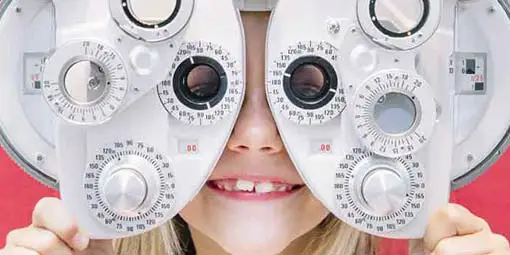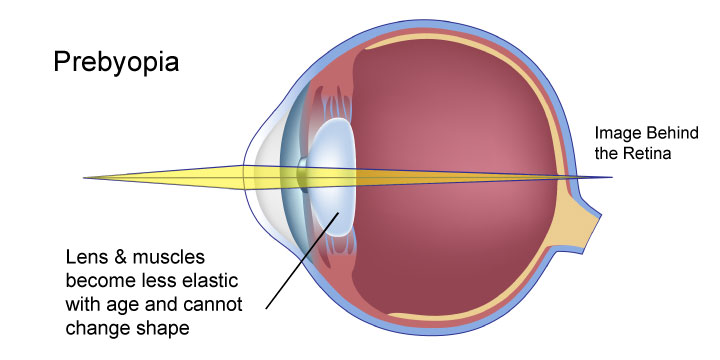Presbyopia - Symptoms, Causes and Treatment
19-05-2025
What is Presbyopia?
Age-Related Blurred Reading Vision
Presbyopia is a common age-related condition that affects the ability of the eye to focus on close objects. It is a natural part of the aging process and typically becomes noticeable around the age of 40. Presbyopia occurs when the lens of the eye loses its flexibility, making it difficult for the eye to adjust and focus on near objects. This can lead to difficulties with activities such as reading, sewing, or using a computer.What Causes Presbyopia?
Age-Related Hardening Of The Lens
Presbyopia is a naturally occurring age-related condition that is caused by the gradual hardening of the lens inside the eye. This hardening causes the lens to become less flexible, making it more difficult for the eye to focus on close objects. As a result, individuals with presbyopia may experience difficulty reading or performing other tasks that require near vision. This process typically begins around the age of 40 and continues to progress over time.What Are The Risk Factors For Presbyopia?
Presbyopia is Age-Related
Risk factors for Presbyopia include aging, family history of the condition, certain medical conditions such as diabetes or cardiovascular disease, and certain medications that can affect vision. Additionally, individuals who spend a significant amount of time reading or working on computers may be at a higher risk for developing Presbyopia. It is important for individuals with these risk factors to be aware of the potential for developing Presbyopia and to schedule regular eye exams to monitor their vision.What Are Symptoms Of Presbyopia?
Difficulty Reading Fine Print
Symptoms of Presbyopia typically include difficulty reading small print, holding reading material at arm's length to see it more clearly, eyestrain or headaches when doing close work, and blurred vision at normal reading distances. Individuals with Presbyopia may also experience difficulty seeing objects up close in low light conditions. These symptoms can gradually worsen over time as the eye's ability to focus on close objects diminishes.How is Presbyopia Diagnosed?
Annual Eye Exams
Presbyopia is diagnosed through a comprehensive eye examination conducted by an optometrist. The exam typically includes a review of the patient's medical history, a visual acuity test, a refraction test to determine the prescription for corrective lenses, as well as a test to measure how well the eyes focus at various distances. Additionally, the optometrist may perform a test to measure the eye's ability to change focus and accommodate for near vision. By evaluating these factors, the optometrist can accurately diagnose presbyopia and recommend appropriate treatment options to improve the patient's near vision.How is Presbyopia Treated?
Multifocal Prescription Eyewear
Presbyopia can be effectively treated through various methods depending on the severity of the condition. One common option is the use of reading glasses or bifocal lenses or progressive lenses, which can help correct near vision for activities such as reading or using a computer. Another option is multifocal contact lenses, which provide clear vision at multiple distances. For those seeking a more permanent solution, surgical options such as conductive keratoplasty or monovision LASIK may be considered. It is important for individuals experiencing symptoms of Presbyopia to consult with their optometrist to determine the most suitable treatment option for their specific needs.
Is There A Cure For Presbyopia?
Only The Fountain of Youth
Presbyopia is a common age-related vision condition that affects many people as they get older. Unfortunately, there is no cure for Presbyopia. However, there are several treatment options available to help manage the symptoms and improve vision for those affected by this condition. These treatments may include prescription eyeglasses, contact lenses, or surgical procedures such as monovision or multifocal lens implants. It is important for individuals with Presbyopia to regularly visit their eye care provider to ensure their vision needs are being met and to discuss the best treatment options for their specific situation.How Can Presbyopia Be Prevented?
Presbyopia Is Part Of The Aging Process
Presbyopia cannot be prevented, as it is a natural and inevitable part of the aging process. However, there are ways to help manage and alleviate the symptoms of presbyopia. Regular eye exams are essential to monitor changes in vision and ensure that the correct prescription for reading glasses or contact lenses is being used. Additionally, maintaining a healthy lifestyle that includes a balanced diet, regular exercise, and protecting the eyes from harmful UV rays can help support overall eye health as you age. It is important to consult with an optometrist for personalized recommendations and guidance on how to best manage presbyopia.Regular eye exams with advanced technologies are essential for the early diagnosis and treatment of presbyopia. Schedule an eye exam with an optometrist today!
Schedule An AppointmentFYEyes Blog Posts

Astigmatism - Symptoms, Causes and Treatment
A refractive error caused by a cornea or lens of the eye that is not perfectly symmetrical.

Hyperopia - Symptoms, Causes and Treatment
A refractive error that affects the eye's ability to focus on near objects.


Refractive Errors - Symptoms, Causes and Treatment
Refractive errors are common eye conditions that affect how the eye focuses light.

Adult Eye Exams
Our advanced eye exams consist of 25+ modern tests and digital scans to assess eye health, function, and visual acuity.

Child Eye Exams
Give your child a clear future with an annual eye exam from our experienced Edmonton optometrists.

Senior Eye Exams
Maintain your vision through your golden years with gold standard eye care from the optometrists at our Edmonton eye clinic.

Contact Lens Eye Exams
Our eye exams for contact lens wearers include test and digital scans to assess eye health, function, visual acuity, and lens fit.

Diabetic Eye Exams
Managing diabetes requires regular eye exams to ensure that diabetes is not causing irreversible vision loss.

Dilated Eye Exams
Dilating the eyes enables our Edmonton optometrists to see more of the eye so that you many never see less.
Our Edmonton Eye Exams Are Comprised Of 4 Phases Of Evaluation

1. Eye Exam Pre-Testing
Corneal Thickness | Intraocular Pressures | Visual Field
Pre-testing is a detailed process that gathers all necessary information for the optometrist in advance of the optometrist-administered eye examination. This process involves completing a detailed patient history, as well as a series of standard tests. Pre-testing is an essential part of the comprehensive eye exam process, providing valuable information and visuals for both the optometrist and the patient.
More About Pre-Testing »
2. Advanced Diagnostic Testing
Retinal Photography, OCT, Topography
eye-deology Vision Care differentiates itself from other clinics by having the most advanced modern diagnostic specialty testing equipment. Specialty equipment, such as a wide-angle high-resolution retinal imager, Optical Coherence Tomography (OCT), Humphrey Visual Field Analyzer and corneal topographer, ensures that patients receive the best comprehensive eye care.
More About Advanced Testing »
3. Optometrist Examination
Health Assessment & Disease Diagnosis
eye-deology Vision Care Edmonton optometrists perform a multitude of tests and assessments to evaluate ocular health, eye coordination, and visual acuity. In addition, they also evaluate the results of the tests and scans performed during pre-testing. As part of patient education, our optometrists also take the time to show and explain results to patients.
More About Doctor Exam »
4. Eye Glass Consult
Prescription | Lens Selection | Digital Fitting
If you require corrective lenses to improve your vision, our licensed opticians will customize their fit to your unique attributes, needs, lifestyle, and budget. Our opticians are happy to provide you with information about the latest eyeglass frame and lens technologies available so you can make informed decisions and begin seeing and looking your best.
More About Eyewear Consult »